Human Resource Management Report: CIPD and Ulrich's Models Analysis
VerifiedAdded on 2020/02/03
|14
|2892
|108
Report
AI Summary
This report provides an in-depth analysis of Human Resource Management (HRM), focusing on the professional behaviors and competencies crucial for effective HR professionals. It begins with an executive summary, followed by an introduction that emphasizes the importance of HR professionals in organizational success. The report explores eight key professional behaviors identified by the Chartered Institute of Personnel and Development (CIPD), including curiosity, decisive thinking, skilled influencing, personal credibility, collaboration, driven delivery, courage to challenge, and role modeling. It then compares CIPD's professional map with David Ulrich's competency model, which categorizes competencies into organization enablers, core competencies, and delivery enablers. The report highlights the differences between the two models, emphasizing competencies like strategic positioning, credible activism, paradox navigation, and others. The conclusion summarizes the key takeaways, underscoring the importance of specific behaviors and competencies for HR professionals to achieve their goals. The report emphasizes the importance of communication, critical thinking, interpersonal skills, and leadership skills within the HR field.
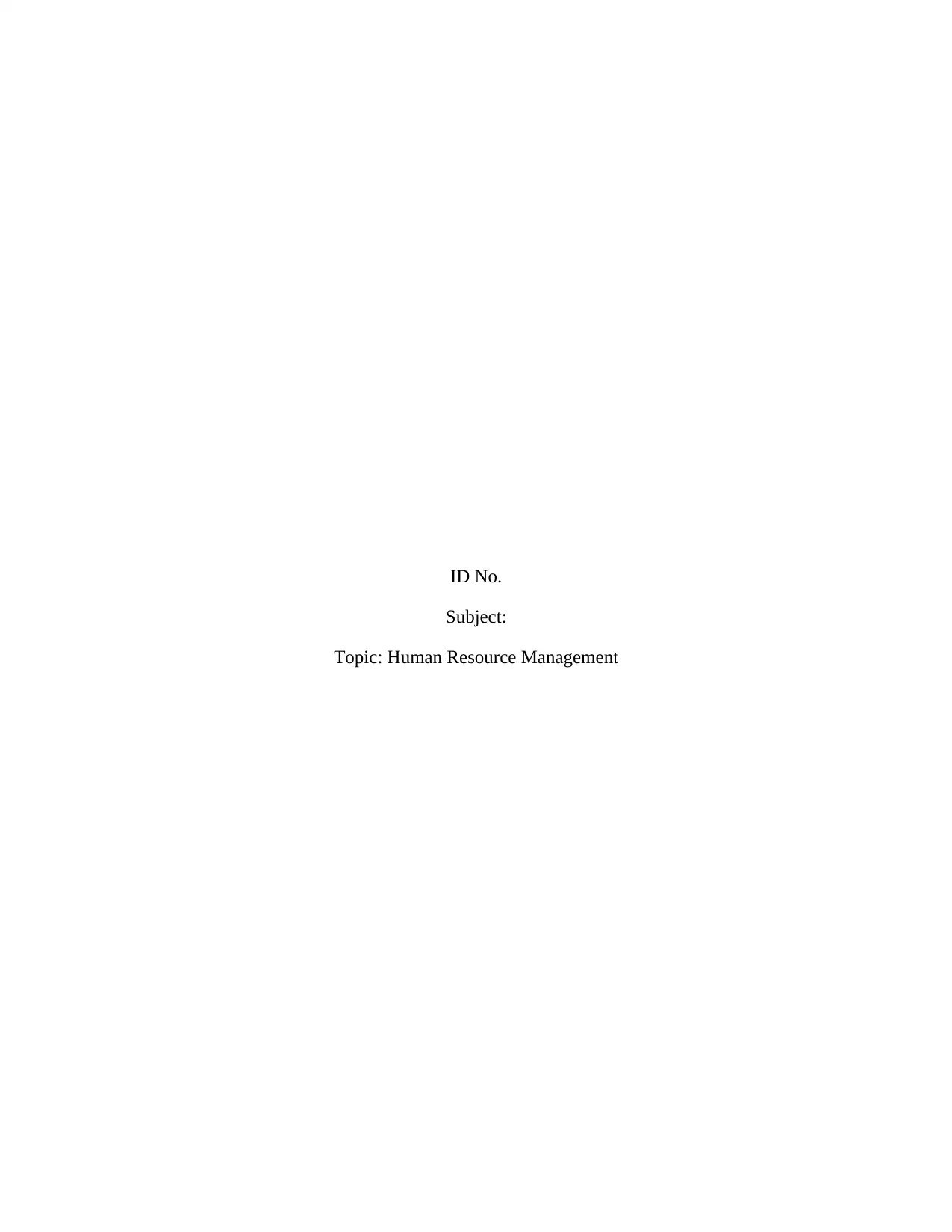
ID No.
Subject:
Topic: Human Resource Management
Subject:
Topic: Human Resource Management
Paraphrase This Document
Need a fresh take? Get an instant paraphrase of this document with our AI Paraphraser

2
HUMAN RESOURCE MANAGEMENT
Executive summary
In human resource management, many professionals have conducted surveys and research, with
the goal of improving the services provided by human research professionals. One of those
professional teams is CIPD which have come up with a professional map that explains some
behaviors that if possessed by HR professionals, they would fulfill their professional obligation
adequately. Another person who has put a lot of effort in this field is David Ulrich. For many
years he has come up with several models describing the level of competencies that should be
practiced by HR professionals towards the success of the company. In this report, we will study
the professional map from CIPD and David Ulrich's competency model as well.
HUMAN RESOURCE MANAGEMENT
Executive summary
In human resource management, many professionals have conducted surveys and research, with
the goal of improving the services provided by human research professionals. One of those
professional teams is CIPD which have come up with a professional map that explains some
behaviors that if possessed by HR professionals, they would fulfill their professional obligation
adequately. Another person who has put a lot of effort in this field is David Ulrich. For many
years he has come up with several models describing the level of competencies that should be
practiced by HR professionals towards the success of the company. In this report, we will study
the professional map from CIPD and David Ulrich's competency model as well.
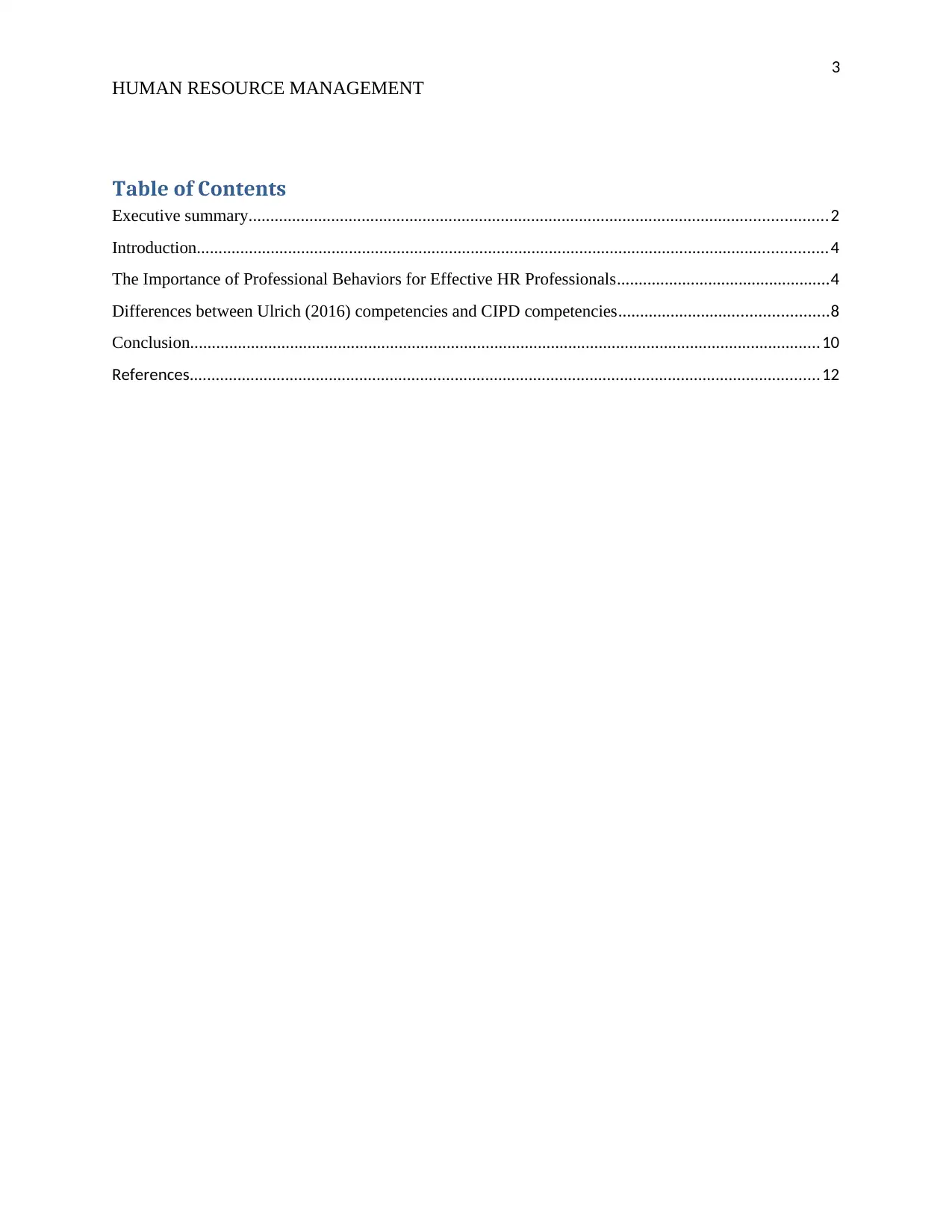
3
HUMAN RESOURCE MANAGEMENT
Table of Contents
Executive summary.....................................................................................................................................2
Introduction.................................................................................................................................................4
The Importance of Professional Behaviors for Effective HR Professionals.................................................4
Differences between Ulrich (2016) competencies and CIPD competencies................................................8
Conclusion.................................................................................................................................................10
References.................................................................................................................................................12
HUMAN RESOURCE MANAGEMENT
Table of Contents
Executive summary.....................................................................................................................................2
Introduction.................................................................................................................................................4
The Importance of Professional Behaviors for Effective HR Professionals.................................................4
Differences between Ulrich (2016) competencies and CIPD competencies................................................8
Conclusion.................................................................................................................................................10
References.................................................................................................................................................12
⊘ This is a preview!⊘
Do you want full access?
Subscribe today to unlock all pages.

Trusted by 1+ million students worldwide
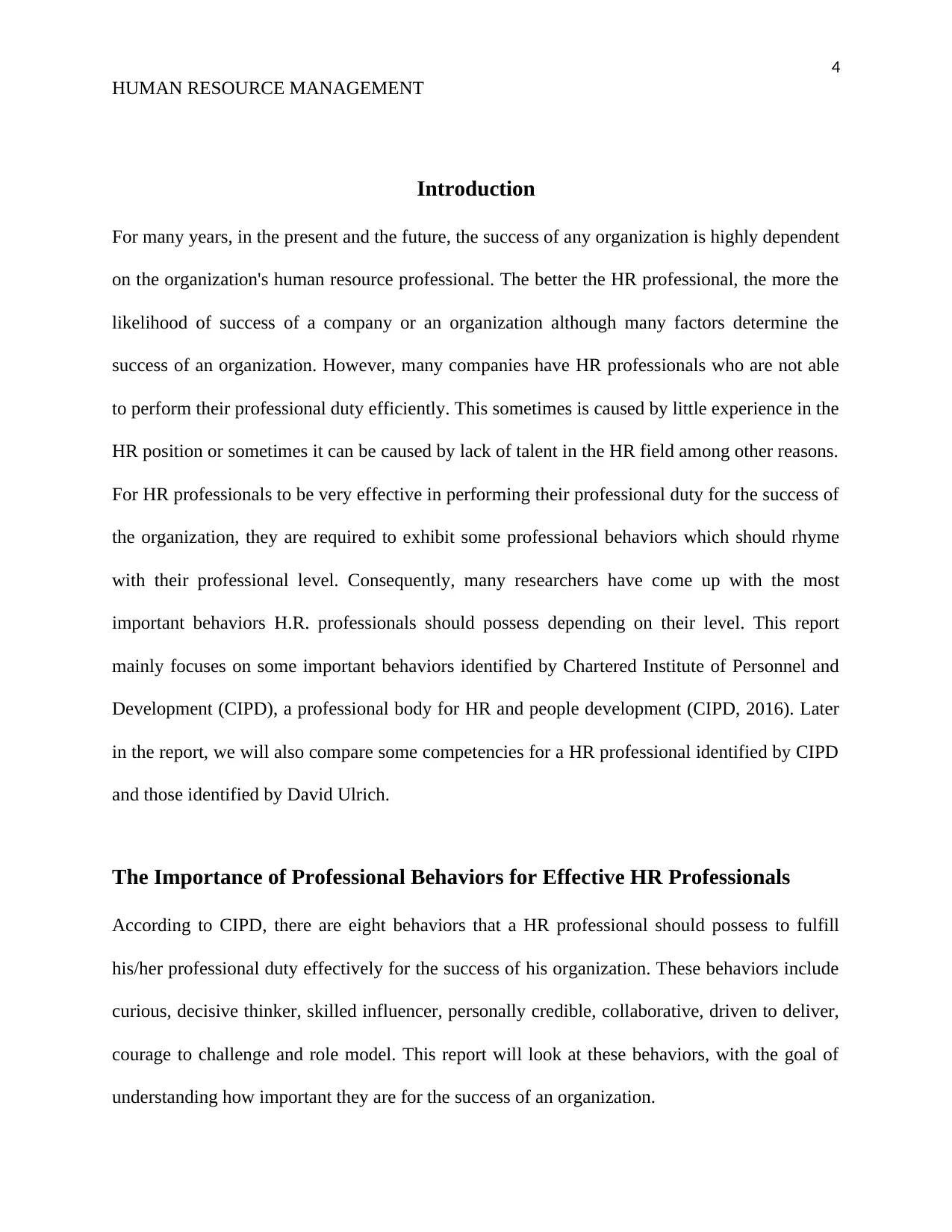
4
HUMAN RESOURCE MANAGEMENT
Introduction
For many years, in the present and the future, the success of any organization is highly dependent
on the organization's human resource professional. The better the HR professional, the more the
likelihood of success of a company or an organization although many factors determine the
success of an organization. However, many companies have HR professionals who are not able
to perform their professional duty efficiently. This sometimes is caused by little experience in the
HR position or sometimes it can be caused by lack of talent in the HR field among other reasons.
For HR professionals to be very effective in performing their professional duty for the success of
the organization, they are required to exhibit some professional behaviors which should rhyme
with their professional level. Consequently, many researchers have come up with the most
important behaviors H.R. professionals should possess depending on their level. This report
mainly focuses on some important behaviors identified by Chartered Institute of Personnel and
Development (CIPD), a professional body for HR and people development (CIPD, 2016). Later
in the report, we will also compare some competencies for a HR professional identified by CIPD
and those identified by David Ulrich.
The Importance of Professional Behaviors for Effective HR Professionals
According to CIPD, there are eight behaviors that a HR professional should possess to fulfill
his/her professional duty effectively for the success of his organization. These behaviors include
curious, decisive thinker, skilled influencer, personally credible, collaborative, driven to deliver,
courage to challenge and role model. This report will look at these behaviors, with the goal of
understanding how important they are for the success of an organization.
HUMAN RESOURCE MANAGEMENT
Introduction
For many years, in the present and the future, the success of any organization is highly dependent
on the organization's human resource professional. The better the HR professional, the more the
likelihood of success of a company or an organization although many factors determine the
success of an organization. However, many companies have HR professionals who are not able
to perform their professional duty efficiently. This sometimes is caused by little experience in the
HR position or sometimes it can be caused by lack of talent in the HR field among other reasons.
For HR professionals to be very effective in performing their professional duty for the success of
the organization, they are required to exhibit some professional behaviors which should rhyme
with their professional level. Consequently, many researchers have come up with the most
important behaviors H.R. professionals should possess depending on their level. This report
mainly focuses on some important behaviors identified by Chartered Institute of Personnel and
Development (CIPD), a professional body for HR and people development (CIPD, 2016). Later
in the report, we will also compare some competencies for a HR professional identified by CIPD
and those identified by David Ulrich.
The Importance of Professional Behaviors for Effective HR Professionals
According to CIPD, there are eight behaviors that a HR professional should possess to fulfill
his/her professional duty effectively for the success of his organization. These behaviors include
curious, decisive thinker, skilled influencer, personally credible, collaborative, driven to deliver,
courage to challenge and role model. This report will look at these behaviors, with the goal of
understanding how important they are for the success of an organization.
Paraphrase This Document
Need a fresh take? Get an instant paraphrase of this document with our AI Paraphraser

5
HUMAN RESOURCE MANAGEMENT
Curious
A person who is curious is the one who is interested in learning about people or things around
him/her (Cambridge Dictionary, 2016). In this context, a curious HR professional is one who is
future-focused, inquisitive and open-minded (CIPD, 2016b). He is a person who comes up with
innovative ways which add value to the organization. According to CIPD (2016), there are some
indicators, such that if you find a professional who is practicing them, then he/she cannot be
referred to as a curious HR. some of these contra-indicators include:
Takes the immediate information and presumes it to be true even when the information is
unclear.
Instead of following the right procedure of inquiry, he needs to know all the answers.
Rejects an idea without thinking about the benefits it would bring to the organization.
Does not look at the organization's future but focuses on present and the past
A curious professional brings benefits to the organization in that he can know how each
department or individual are doing the organizational goals. Concerning business suitability to
the market, they can know how other similar organizations are competing. A curious
professional is also up to date with all job requirements (Ciprian.arhire, 2014).
Decisive thinker
This is a professional who displays the ability to examine and understand data and information
quickly (CIPD, 2016b). They can use information knowledgeably to help them make
recommendations and tenable decisions. There are also some things that decisive thinkers don't
HUMAN RESOURCE MANAGEMENT
Curious
A person who is curious is the one who is interested in learning about people or things around
him/her (Cambridge Dictionary, 2016). In this context, a curious HR professional is one who is
future-focused, inquisitive and open-minded (CIPD, 2016b). He is a person who comes up with
innovative ways which add value to the organization. According to CIPD (2016), there are some
indicators, such that if you find a professional who is practicing them, then he/she cannot be
referred to as a curious HR. some of these contra-indicators include:
Takes the immediate information and presumes it to be true even when the information is
unclear.
Instead of following the right procedure of inquiry, he needs to know all the answers.
Rejects an idea without thinking about the benefits it would bring to the organization.
Does not look at the organization's future but focuses on present and the past
A curious professional brings benefits to the organization in that he can know how each
department or individual are doing the organizational goals. Concerning business suitability to
the market, they can know how other similar organizations are competing. A curious
professional is also up to date with all job requirements (Ciprian.arhire, 2014).
Decisive thinker
This is a professional who displays the ability to examine and understand data and information
quickly (CIPD, 2016b). They can use information knowledgeably to help them make
recommendations and tenable decisions. There are also some things that decisive thinkers don't

6
HUMAN RESOURCE MANAGEMENT
do like; focusing on symptoms rather than causes, making fundamental errors in data analysis,
just accepting data without knowing the source just to mention a few. A professional who
practices this behavior can lead his people to achieve a given task efficiently and within a
reasonable time (Ajuwat, 2016). In general, they can approach a problem intuitively with a good
understanding of the internal and external environment.
Skilled influencer
For the organization's benefit, a skilled influencer can gain the necessary commitment and
support from people within and beyond the organization (Orme, 2010). If you come across a HR
professional who is practicing some of the below traits then he/she is not a skilled influencer;
does not give credit where it's due, goes to meetings or interactions without adequate preparation,
over-relies on a single strategy to solve all problems just to mention several. A manager with this
behavior can build strong interpersonal relationships and have a better understanding and
judgment of situations (Taylor, 2015).
Personally credible
A personally credible person is one who can think reasonably, make better judgments and use
emotional intelligence to defend decisions (Orme, 2010). They bring value to the organization
through combining commercial and HR expertise (CIPD, 2016b). Personal credibility is a very
basic foundation in human resource management as it builds a relationship of trust with their
clients and instills confidence (Eaden, 2006).
HUMAN RESOURCE MANAGEMENT
do like; focusing on symptoms rather than causes, making fundamental errors in data analysis,
just accepting data without knowing the source just to mention a few. A professional who
practices this behavior can lead his people to achieve a given task efficiently and within a
reasonable time (Ajuwat, 2016). In general, they can approach a problem intuitively with a good
understanding of the internal and external environment.
Skilled influencer
For the organization's benefit, a skilled influencer can gain the necessary commitment and
support from people within and beyond the organization (Orme, 2010). If you come across a HR
professional who is practicing some of the below traits then he/she is not a skilled influencer;
does not give credit where it's due, goes to meetings or interactions without adequate preparation,
over-relies on a single strategy to solve all problems just to mention several. A manager with this
behavior can build strong interpersonal relationships and have a better understanding and
judgment of situations (Taylor, 2015).
Personally credible
A personally credible person is one who can think reasonably, make better judgments and use
emotional intelligence to defend decisions (Orme, 2010). They bring value to the organization
through combining commercial and HR expertise (CIPD, 2016b). Personal credibility is a very
basic foundation in human resource management as it builds a relationship of trust with their
clients and instills confidence (Eaden, 2006).
⊘ This is a preview!⊘
Do you want full access?
Subscribe today to unlock all pages.

Trusted by 1+ million students worldwide

7
HUMAN RESOURCE MANAGEMENT
Collaborative
These are HR professionals who can work effectively with clients, stakeholders, colleagues and
other wide range of people within and beyond the organization for its benefit (Orme, 2010).
They are characterized by traits such as; they can build contact with people who are beyond their
work area, they recognize the value of diversity, they don't work consistently in isolation but
involves the stakeholders. They also listen and show interest in other peoples' views.
Driven to deliver
With this behavior, they are able determined and resourceful, and their main goal is to deliver the
best for the organization's success. The importance of this behavior is that they can recognize
performance issues and deal with them accordingly. They also keep track of progress and don't
give up when faced with obstacles (CIPD, 2016b).
Courage to challenge
They can challenge views which seem to disadvantage the organization. They don't avoid
difficult conversations, and they show confidence in knowledge, abilities, and judgments.
Role model
This is another important quality of a good HR. they lead by example and performs their job with
integrity and impartiality. This is important because the HR will always perform his duties
professionally and always makes sound judgments in every situation (Orme, 2010).
HUMAN RESOURCE MANAGEMENT
Collaborative
These are HR professionals who can work effectively with clients, stakeholders, colleagues and
other wide range of people within and beyond the organization for its benefit (Orme, 2010).
They are characterized by traits such as; they can build contact with people who are beyond their
work area, they recognize the value of diversity, they don't work consistently in isolation but
involves the stakeholders. They also listen and show interest in other peoples' views.
Driven to deliver
With this behavior, they are able determined and resourceful, and their main goal is to deliver the
best for the organization's success. The importance of this behavior is that they can recognize
performance issues and deal with them accordingly. They also keep track of progress and don't
give up when faced with obstacles (CIPD, 2016b).
Courage to challenge
They can challenge views which seem to disadvantage the organization. They don't avoid
difficult conversations, and they show confidence in knowledge, abilities, and judgments.
Role model
This is another important quality of a good HR. they lead by example and performs their job with
integrity and impartiality. This is important because the HR will always perform his duties
professionally and always makes sound judgments in every situation (Orme, 2010).
Paraphrase This Document
Need a fresh take? Get an instant paraphrase of this document with our AI Paraphraser
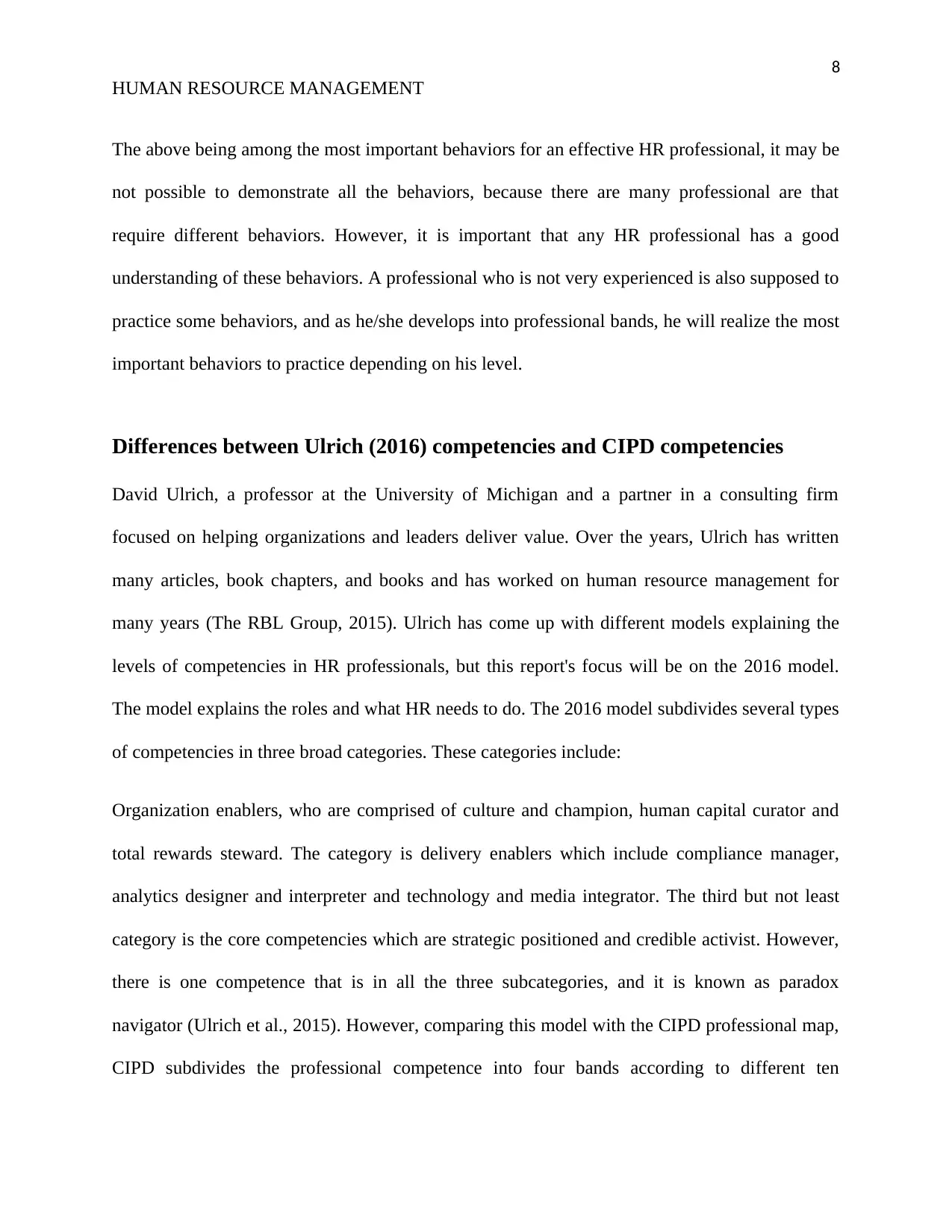
8
HUMAN RESOURCE MANAGEMENT
The above being among the most important behaviors for an effective HR professional, it may be
not possible to demonstrate all the behaviors, because there are many professional are that
require different behaviors. However, it is important that any HR professional has a good
understanding of these behaviors. A professional who is not very experienced is also supposed to
practice some behaviors, and as he/she develops into professional bands, he will realize the most
important behaviors to practice depending on his level.
Differences between Ulrich (2016) competencies and CIPD competencies
David Ulrich, a professor at the University of Michigan and a partner in a consulting firm
focused on helping organizations and leaders deliver value. Over the years, Ulrich has written
many articles, book chapters, and books and has worked on human resource management for
many years (The RBL Group, 2015). Ulrich has come up with different models explaining the
levels of competencies in HR professionals, but this report's focus will be on the 2016 model.
The model explains the roles and what HR needs to do. The 2016 model subdivides several types
of competencies in three broad categories. These categories include:
Organization enablers, who are comprised of culture and champion, human capital curator and
total rewards steward. The category is delivery enablers which include compliance manager,
analytics designer and interpreter and technology and media integrator. The third but not least
category is the core competencies which are strategic positioned and credible activist. However,
there is one competence that is in all the three subcategories, and it is known as paradox
navigator (Ulrich et al., 2015). However, comparing this model with the CIPD professional map,
CIPD subdivides the professional competence into four bands according to different ten
HUMAN RESOURCE MANAGEMENT
The above being among the most important behaviors for an effective HR professional, it may be
not possible to demonstrate all the behaviors, because there are many professional are that
require different behaviors. However, it is important that any HR professional has a good
understanding of these behaviors. A professional who is not very experienced is also supposed to
practice some behaviors, and as he/she develops into professional bands, he will realize the most
important behaviors to practice depending on his level.
Differences between Ulrich (2016) competencies and CIPD competencies
David Ulrich, a professor at the University of Michigan and a partner in a consulting firm
focused on helping organizations and leaders deliver value. Over the years, Ulrich has written
many articles, book chapters, and books and has worked on human resource management for
many years (The RBL Group, 2015). Ulrich has come up with different models explaining the
levels of competencies in HR professionals, but this report's focus will be on the 2016 model.
The model explains the roles and what HR needs to do. The 2016 model subdivides several types
of competencies in three broad categories. These categories include:
Organization enablers, who are comprised of culture and champion, human capital curator and
total rewards steward. The category is delivery enablers which include compliance manager,
analytics designer and interpreter and technology and media integrator. The third but not least
category is the core competencies which are strategic positioned and credible activist. However,
there is one competence that is in all the three subcategories, and it is known as paradox
navigator (Ulrich et al., 2015). However, comparing this model with the CIPD professional map,
CIPD subdivides the professional competence into four bands according to different ten
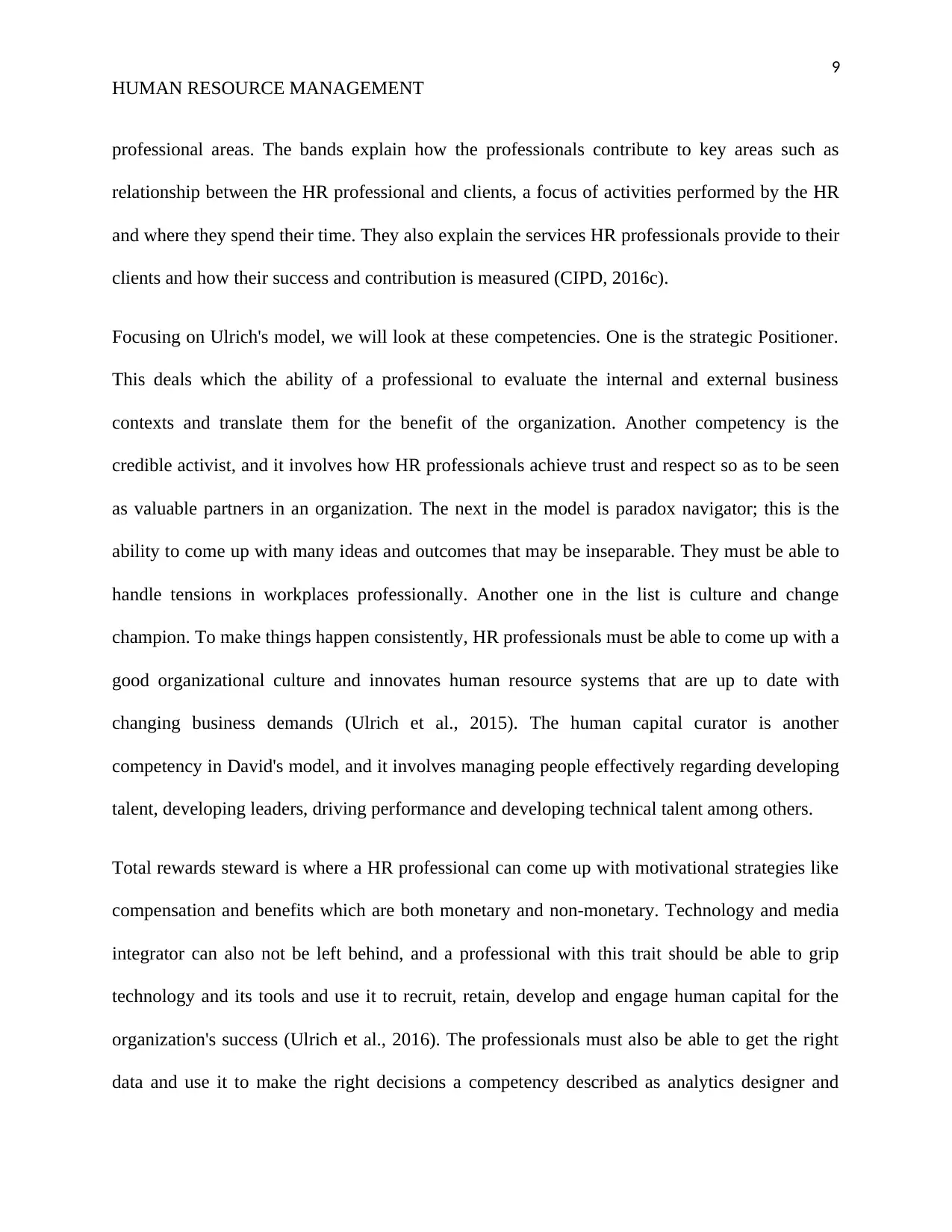
9
HUMAN RESOURCE MANAGEMENT
professional areas. The bands explain how the professionals contribute to key areas such as
relationship between the HR professional and clients, a focus of activities performed by the HR
and where they spend their time. They also explain the services HR professionals provide to their
clients and how their success and contribution is measured (CIPD, 2016c).
Focusing on Ulrich's model, we will look at these competencies. One is the strategic Positioner.
This deals which the ability of a professional to evaluate the internal and external business
contexts and translate them for the benefit of the organization. Another competency is the
credible activist, and it involves how HR professionals achieve trust and respect so as to be seen
as valuable partners in an organization. The next in the model is paradox navigator; this is the
ability to come up with many ideas and outcomes that may be inseparable. They must be able to
handle tensions in workplaces professionally. Another one in the list is culture and change
champion. To make things happen consistently, HR professionals must be able to come up with a
good organizational culture and innovates human resource systems that are up to date with
changing business demands (Ulrich et al., 2015). The human capital curator is another
competency in David's model, and it involves managing people effectively regarding developing
talent, developing leaders, driving performance and developing technical talent among others.
Total rewards steward is where a HR professional can come up with motivational strategies like
compensation and benefits which are both monetary and non-monetary. Technology and media
integrator can also not be left behind, and a professional with this trait should be able to grip
technology and its tools and use it to recruit, retain, develop and engage human capital for the
organization's success (Ulrich et al., 2016). The professionals must also be able to get the right
data and use it to make the right decisions a competency described as analytics designer and
HUMAN RESOURCE MANAGEMENT
professional areas. The bands explain how the professionals contribute to key areas such as
relationship between the HR professional and clients, a focus of activities performed by the HR
and where they spend their time. They also explain the services HR professionals provide to their
clients and how their success and contribution is measured (CIPD, 2016c).
Focusing on Ulrich's model, we will look at these competencies. One is the strategic Positioner.
This deals which the ability of a professional to evaluate the internal and external business
contexts and translate them for the benefit of the organization. Another competency is the
credible activist, and it involves how HR professionals achieve trust and respect so as to be seen
as valuable partners in an organization. The next in the model is paradox navigator; this is the
ability to come up with many ideas and outcomes that may be inseparable. They must be able to
handle tensions in workplaces professionally. Another one in the list is culture and change
champion. To make things happen consistently, HR professionals must be able to come up with a
good organizational culture and innovates human resource systems that are up to date with
changing business demands (Ulrich et al., 2015). The human capital curator is another
competency in David's model, and it involves managing people effectively regarding developing
talent, developing leaders, driving performance and developing technical talent among others.
Total rewards steward is where a HR professional can come up with motivational strategies like
compensation and benefits which are both monetary and non-monetary. Technology and media
integrator can also not be left behind, and a professional with this trait should be able to grip
technology and its tools and use it to recruit, retain, develop and engage human capital for the
organization's success (Ulrich et al., 2016). The professionals must also be able to get the right
data and use it to make the right decisions a competency described as analytics designer and
⊘ This is a preview!⊘
Do you want full access?
Subscribe today to unlock all pages.

Trusted by 1+ million students worldwide

10
HUMAN RESOURCE MANAGEMENT
interpreter by Ulrich. The last but not least is the compliance manager. This is a manager who
can ensure that his practices are in compliance with government laws and also supports
employee rights.
One major difference between Ulrich's competencies and CIPD competencies is that in CPID,
the professionals are divided into four bands according to ten professional areas while in Ulrich's
model, the competencies are subdivided according to organization enablers, core competencies,
and delivery enablers. CIPD also explains how to a HR professional can progress from one band
to another through practicing some several professional behaviors. Ulrich's model, however, tells
about how the HR professionals perform their roles and exactly what they are supposed to do to
achieve their professional goal. In the above two models, we can summarize the competencies
and highlight the most important ones. One of them is communication. Communicating with
everyone in the workplace effectively is very important for a HR professional. They should also
be able to analyze and think critically in many areas. They should also build a strong relationship
which improves their interpersonal skills and consequently a successful organization is a result.
Good leadership skills should also be exhibited by HR professionals as they also play a key role
in the success of the HR professional and the organization (Mayhew, no date).
Conclusion
After studying the professional map by CIPD, David Ulrich's competency models and other
helpful articles, it is now clear that, their specific behaviors that a Human Resource professional
should fulfill his/her professional goal. It is also clear that there are some skills or competencies
HUMAN RESOURCE MANAGEMENT
interpreter by Ulrich. The last but not least is the compliance manager. This is a manager who
can ensure that his practices are in compliance with government laws and also supports
employee rights.
One major difference between Ulrich's competencies and CIPD competencies is that in CPID,
the professionals are divided into four bands according to ten professional areas while in Ulrich's
model, the competencies are subdivided according to organization enablers, core competencies,
and delivery enablers. CIPD also explains how to a HR professional can progress from one band
to another through practicing some several professional behaviors. Ulrich's model, however, tells
about how the HR professionals perform their roles and exactly what they are supposed to do to
achieve their professional goal. In the above two models, we can summarize the competencies
and highlight the most important ones. One of them is communication. Communicating with
everyone in the workplace effectively is very important for a HR professional. They should also
be able to analyze and think critically in many areas. They should also build a strong relationship
which improves their interpersonal skills and consequently a successful organization is a result.
Good leadership skills should also be exhibited by HR professionals as they also play a key role
in the success of the HR professional and the organization (Mayhew, no date).
Conclusion
After studying the professional map by CIPD, David Ulrich's competency models and other
helpful articles, it is now clear that, their specific behaviors that a Human Resource professional
should fulfill his/her professional goal. It is also clear that there are some skills or competencies
Paraphrase This Document
Need a fresh take? Get an instant paraphrase of this document with our AI Paraphraser
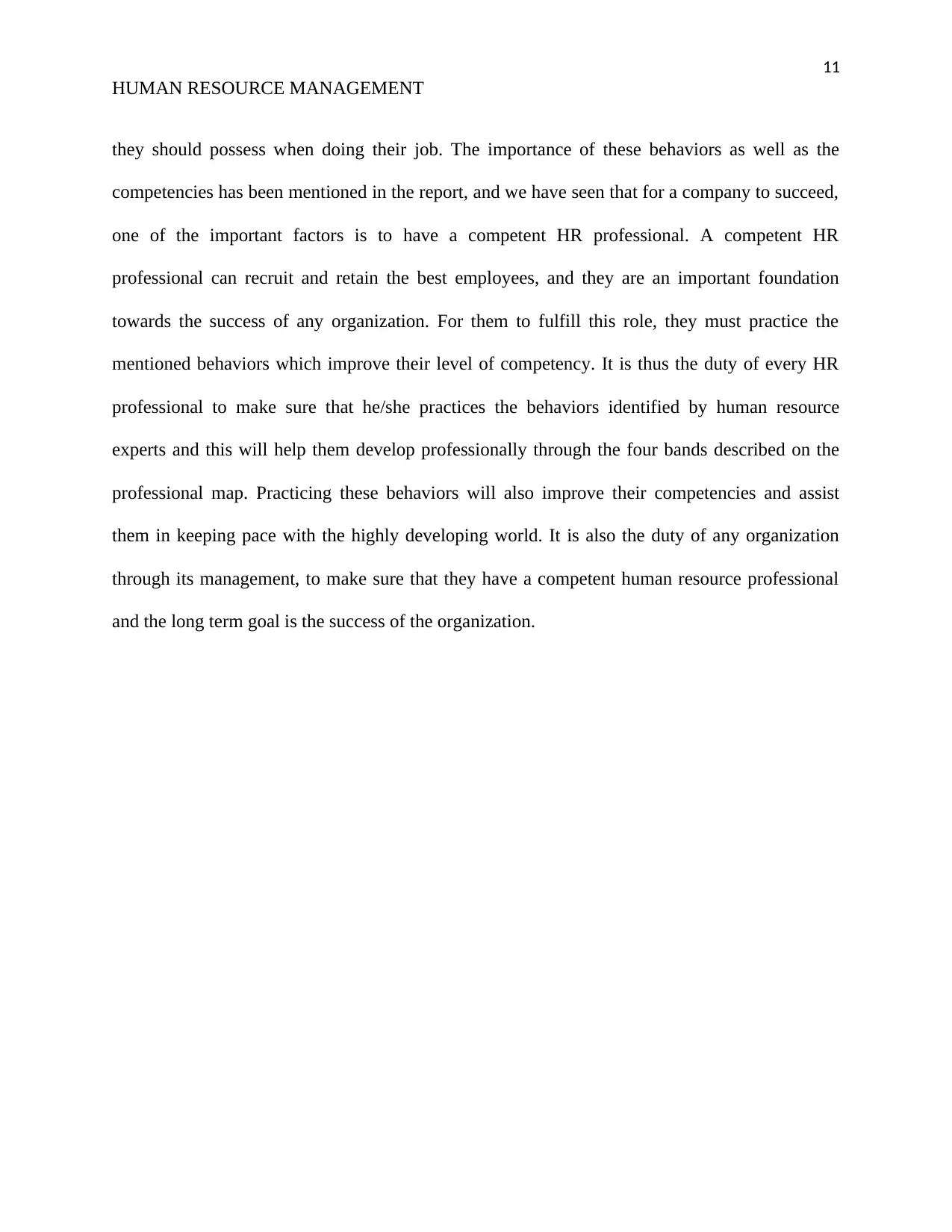
11
HUMAN RESOURCE MANAGEMENT
they should possess when doing their job. The importance of these behaviors as well as the
competencies has been mentioned in the report, and we have seen that for a company to succeed,
one of the important factors is to have a competent HR professional. A competent HR
professional can recruit and retain the best employees, and they are an important foundation
towards the success of any organization. For them to fulfill this role, they must practice the
mentioned behaviors which improve their level of competency. It is thus the duty of every HR
professional to make sure that he/she practices the behaviors identified by human resource
experts and this will help them develop professionally through the four bands described on the
professional map. Practicing these behaviors will also improve their competencies and assist
them in keeping pace with the highly developing world. It is also the duty of any organization
through its management, to make sure that they have a competent human resource professional
and the long term goal is the success of the organization.
HUMAN RESOURCE MANAGEMENT
they should possess when doing their job. The importance of these behaviors as well as the
competencies has been mentioned in the report, and we have seen that for a company to succeed,
one of the important factors is to have a competent HR professional. A competent HR
professional can recruit and retain the best employees, and they are an important foundation
towards the success of any organization. For them to fulfill this role, they must practice the
mentioned behaviors which improve their level of competency. It is thus the duty of every HR
professional to make sure that he/she practices the behaviors identified by human resource
experts and this will help them develop professionally through the four bands described on the
professional map. Practicing these behaviors will also improve their competencies and assist
them in keeping pace with the highly developing world. It is also the duty of any organization
through its management, to make sure that they have a competent human resource professional
and the long term goal is the success of the organization.
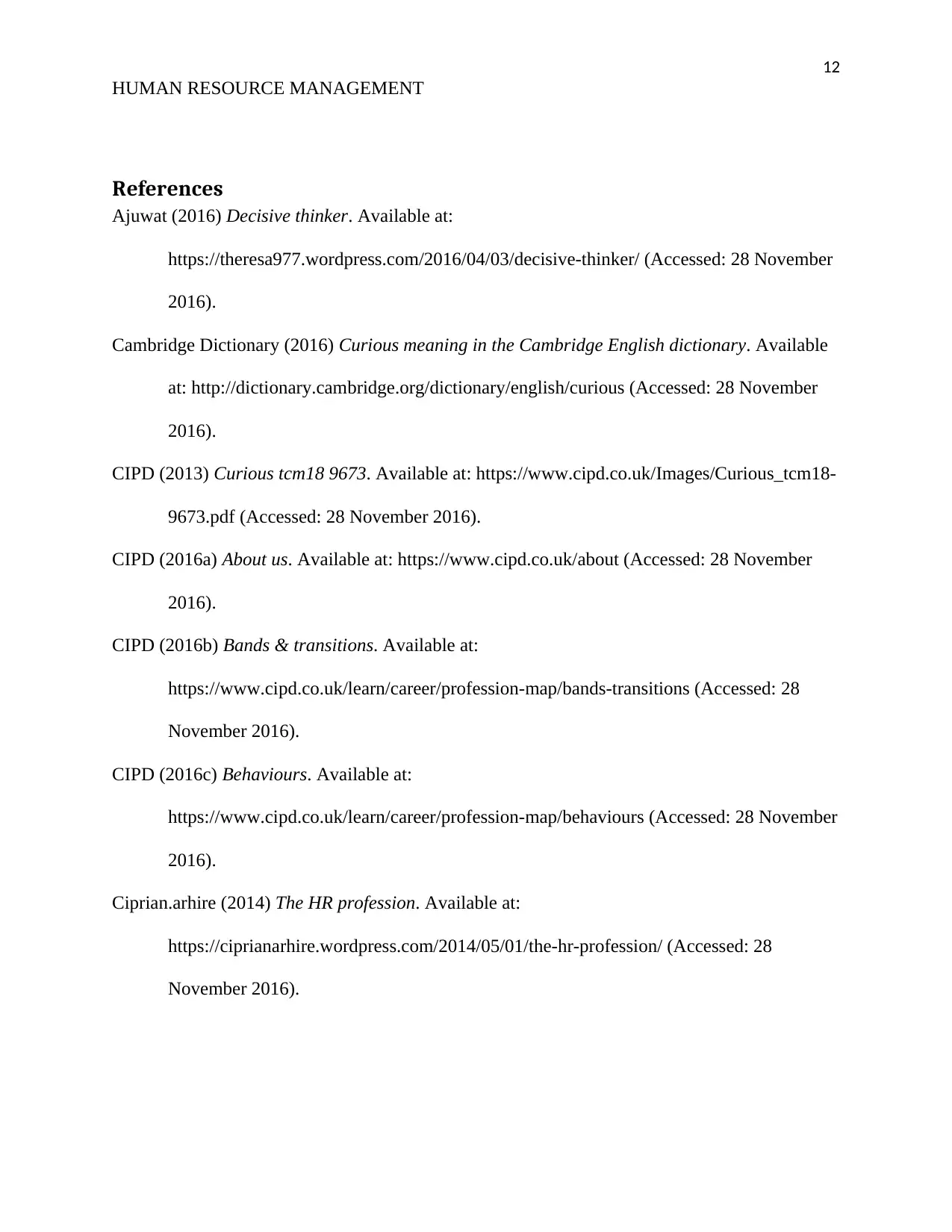
12
HUMAN RESOURCE MANAGEMENT
References
Ajuwat (2016) Decisive thinker. Available at:
https://theresa977.wordpress.com/2016/04/03/decisive-thinker/ (Accessed: 28 November
2016).
Cambridge Dictionary (2016) Curious meaning in the Cambridge English dictionary. Available
at: http://dictionary.cambridge.org/dictionary/english/curious (Accessed: 28 November
2016).
CIPD (2013) Curious tcm18 9673. Available at: https://www.cipd.co.uk/Images/Curious_tcm18-
9673.pdf (Accessed: 28 November 2016).
CIPD (2016a) About us. Available at: https://www.cipd.co.uk/about (Accessed: 28 November
2016).
CIPD (2016b) Bands & transitions. Available at:
https://www.cipd.co.uk/learn/career/profession-map/bands-transitions (Accessed: 28
November 2016).
CIPD (2016c) Behaviours. Available at:
https://www.cipd.co.uk/learn/career/profession-map/behaviours (Accessed: 28 November
2016).
Ciprian.arhire (2014) The HR profession. Available at:
https://ciprianarhire.wordpress.com/2014/05/01/the-hr-profession/ (Accessed: 28
November 2016).
HUMAN RESOURCE MANAGEMENT
References
Ajuwat (2016) Decisive thinker. Available at:
https://theresa977.wordpress.com/2016/04/03/decisive-thinker/ (Accessed: 28 November
2016).
Cambridge Dictionary (2016) Curious meaning in the Cambridge English dictionary. Available
at: http://dictionary.cambridge.org/dictionary/english/curious (Accessed: 28 November
2016).
CIPD (2013) Curious tcm18 9673. Available at: https://www.cipd.co.uk/Images/Curious_tcm18-
9673.pdf (Accessed: 28 November 2016).
CIPD (2016a) About us. Available at: https://www.cipd.co.uk/about (Accessed: 28 November
2016).
CIPD (2016b) Bands & transitions. Available at:
https://www.cipd.co.uk/learn/career/profession-map/bands-transitions (Accessed: 28
November 2016).
CIPD (2016c) Behaviours. Available at:
https://www.cipd.co.uk/learn/career/profession-map/behaviours (Accessed: 28 November
2016).
Ciprian.arhire (2014) The HR profession. Available at:
https://ciprianarhire.wordpress.com/2014/05/01/the-hr-profession/ (Accessed: 28
November 2016).
⊘ This is a preview!⊘
Do you want full access?
Subscribe today to unlock all pages.

Trusted by 1+ million students worldwide
1 out of 14
Related Documents
Your All-in-One AI-Powered Toolkit for Academic Success.
+13062052269
info@desklib.com
Available 24*7 on WhatsApp / Email
![[object Object]](/_next/static/media/star-bottom.7253800d.svg)
Unlock your academic potential
Copyright © 2020–2025 A2Z Services. All Rights Reserved. Developed and managed by ZUCOL.



![5DVP: Developing Professional Practice Report - [University Name]](/_next/image/?url=https%3A%2F%2Fdesklib.com%2Fmedia%2Fimages%2Frq%2Fd1f1fed29d4c4b72b622be5f5f3b52cf.jpg&w=256&q=75)

